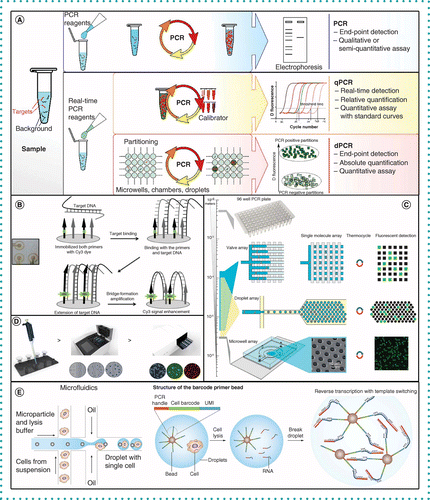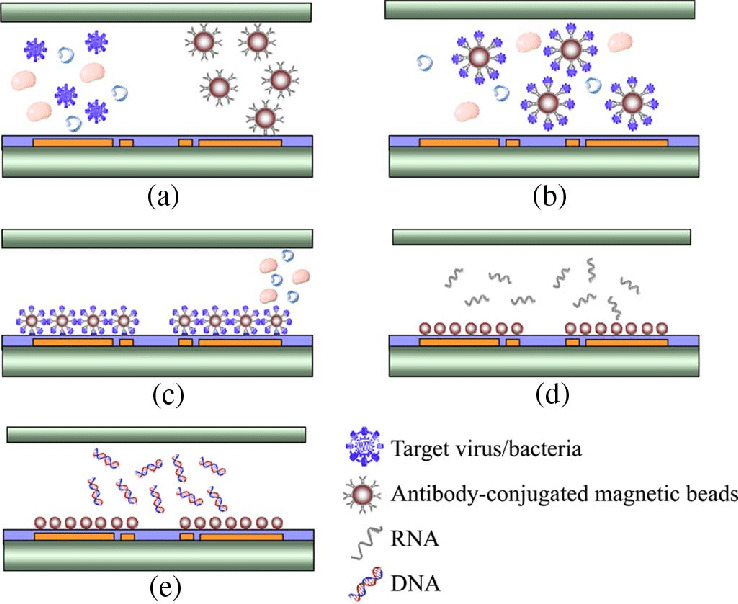PCR is a molecular biology technique that amplifies specific DNA sequences from a sample. It has revolutionized the field by enabling rapid and efficient DNA amplification and is widely used in research and industry.
PCR has advanced genetics by identifying mutations, analyzing gene expression, and sequencing DNA. In forensics, PCR is used to match DNA from crime scenes to suspects or victims. PCR is applied in medicine to diagnose genetic disorders, infectious diseases, and cancers.
Biotechnology uses PCR to clone genes, produce recombinant proteins, and develop gene therapies. PCR is also used in environmental science to monitor microbial populations, detect pollutants, and study microbial diversity. Ongoing developments in PCR technology aim to improve DNA amplification, sensitivity, and accuracy. These advances are crucial for progress in the research industry, and to address new challenges in medicine, agriculture, and ecology.

Improvements in PCR Instrumentation
Multiplex PCR and High-Throughput Sequencing
- Multiplex PCR and High-Throughput Sequencing are two widely used molecular biology techniques in genomics research.
- Multiplex PCR allows the simultaneous amplification of multiple target DNA sequences in a single reaction by using specific primer sets for each target sequence. The amplified products from Multiplex PCR can be detected using different methods like sequencing, gel electrophoresis, etc. This technique is useful in several applications like detecting mutations, genotyping, and identifying pathogens in complex samples.
- High-Throughput Sequencing enables the rapid sequencing of large quantities of DNA or RNA in parallel, using platforms like Illumina, Oxford Nanopore Technologies, and more. It is useful in applications like genome sequencing, transcriptomics, metagenomics, and epigenomics. High-Throughput Sequencing involves fragmenting DNA or RNA into smaller pieces and then sequencing them in parallel.
- Multiplex PCR and High-Throughput Sequencing are used together in several genomics research applications like characterizing microbial communities, analyzing gene expression patterns, and identifying disease-causing mutations. These techniques have revolutionized genomics research by allowing faster, more efficient, and more comprehensive analysis of DNA and RNA.
Overall, Multiplex PCR and High-Throughput Sequencing have significantly contributed to our understanding of genetics and the development of personalized medicine.
Isothermal PCR and Digital PCR
Unlike conventional PCR, real-time PCR is used to quantify the amount of nucleic acid in a given sample whereas absolute quantification requires the use of known standards to calculate the concentration for a sample, while relative quantification uses a “calibrant” to determine the fold change in the sample.
Real-time PCR can be used for direct measurement of DNA targets or it can be coupled with RT-PCR to quantify RNA targets. Digital PCR has only recently become widely available and provides a means to quantify targets in a sample based on direct estimation rather than by making estimates from standard curves. Many isothermal amplification methods have been developed to amplify nucleic acid targets without the need for thermal cycler technologies.
Droplet Digital PCR (ddPCR) is a promising technique for the non-invasive prenatal detection of fetal single-gene point mutations in maternal plasma. It offers high sensitivity, specificity, and reproducibility, allowing for reliable detection and quantification of mutant alleles. Further studies and validation are needed to fully establish its clinical utility and cost-effectiveness.
Challenges and Limitations in the Development of PCR Technology
- RT-PCR tests have played a crucial role in identifying COVID-19 cases, and their accuracy has been enhanced with recent developments.

- Nevertheless, obstacles such as the possibility of inaccurate negative outcomes, problems with gathering and shipping samples, and the requirement for ongoing refining and uniformity of testing procedures still exist.
- The continuous progress and improvement of RT-PCR testing are essential in boosting their precision and accessibility, in the battle against the pandemic.
Recent Innovations in PCR Technology
PCR technology has undergone several innovative developments in recent years, further enhancing its efficiency and applications. Some of the recent innovations in PCR technology are:
CRISPR-Cas technology has revolutionized the field of genome editing, and CRISPR-Cas-assisted PCR enables more efficient and precise gene editing. Ongoing research is expected to lead to continued advancements in CRISPR-based diagnostics, improving accuracy, sensitivity, and ease of use. CRISPR-based COVID-19 testing has the potential to revolutionize infectious disease detection and management, especially for next-generation point-of-care diagnostics.
Loop-mediated isothermal amplification (LAMP) is a novel isothermal amplification method that amplifies DNA with high specificity and speed. It is used for the detection of infectious agents and genetic disorders.
CRISPR-based diagnostic tests use CRISPR-Cas technology to detect specific nucleic acid sequences. They are highly specific and sensitive, enabling the detection of pathogens and genetic disorders with high accuracy.
Final Thoughts on the Future of PCR Technology
PCR technology has transformed the field of molecular biology and has emerged as a potent tool in numerous areas. Like any other technology, PCR is continually progressing, with several advancements anticipated in the future. One such area of progress is the miniaturization of PCR, which allows DNA samples to be analyzed in lesser quantities and at higher rates. Another promising development is the use of PCR for detecting pathogens and infectious diseases, resulting in rapid diagnosis and treatment. The creation of new diagnostic tests based on PCR has been particularly crucial during the ongoing COVID-19 pandemic. Furthermore, the addition of artificial intelligence (AI) and machine learning algorithms to PCR data analysis could assist in automating the process and improving the accuracy of outcomes.
Overall, the future looks bright for PCR technology, with further advancements expected to enhance its effectiveness, speed, and precision, making it an increasingly useful tool in a diverse range of fields.
References
- Hanliang Zhu et.al, https://www.future-science.com/doi/10.2144/btn-2020-0057.
- Microfluidic Systems Integrated With a Sample Pretreatment Device for Fast Nucleic-Acid Amplification May 2008, DOI:10.1109/JMEMS.2008.916295
- PCR, Real-Time PCR, Digital PCR, and Isothermal Amplification Rachel A. Bartholomew, et.al; First published: 01 September 2015,
- Elisabetta D’Aversa, et.al; Droplet Digital PCR for Non-Invasive Prenatal Detection of Fetal Single-Gene Point Mutations in Maternal Plasma, https://doi.org/10.3390%2Fijms23052819
- Manoucher Teymouri et.al; “Recent advances and challenges of RT-PCR tests for the diagnosis of COVID-19″, Pathol Res Pract. 2021 May; 221: 153443, Published online 2021 Apr 14. DOI10.1016/j.prp.2021.153443
- “CRISPR-Based COVID -19 Testing: Toward Next –Generation Point–of–Care Diagnostics”, Front. Cell. Infect. Microbiol., 30 April 2021, Sec. Clinical Microbiology, Volume 11 – 2021, https://doi.org/10.3389/fcimb.2021.663949



